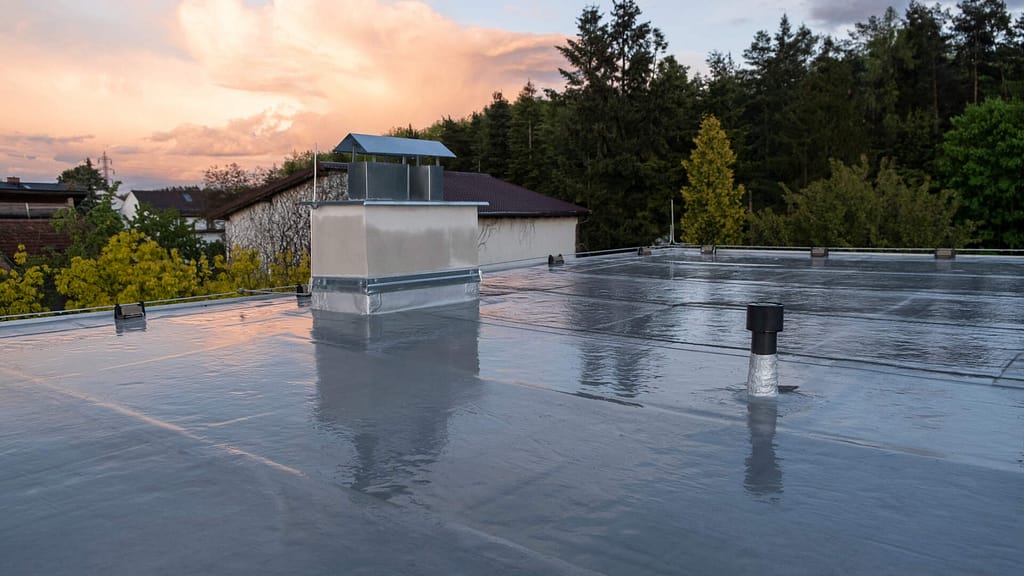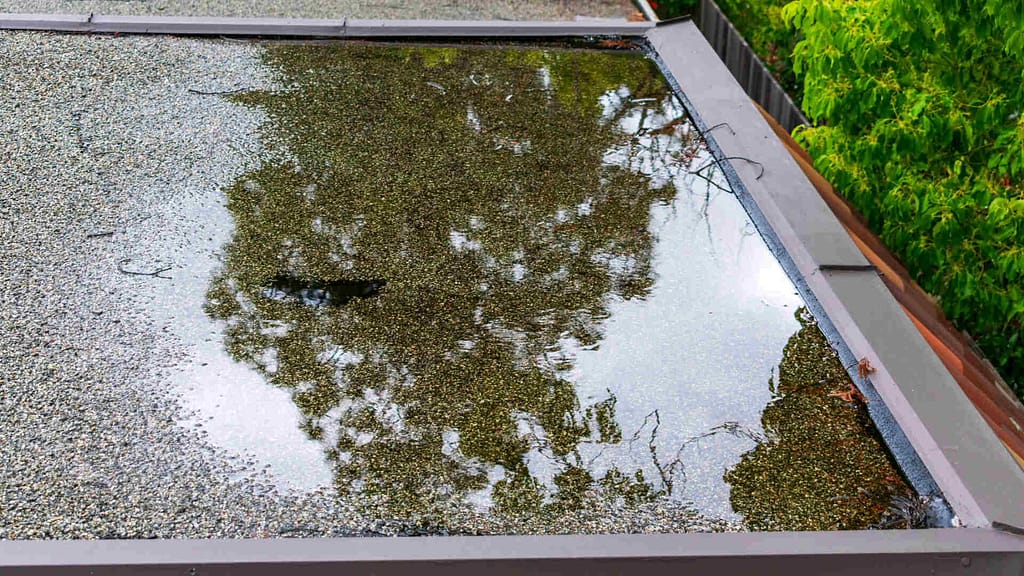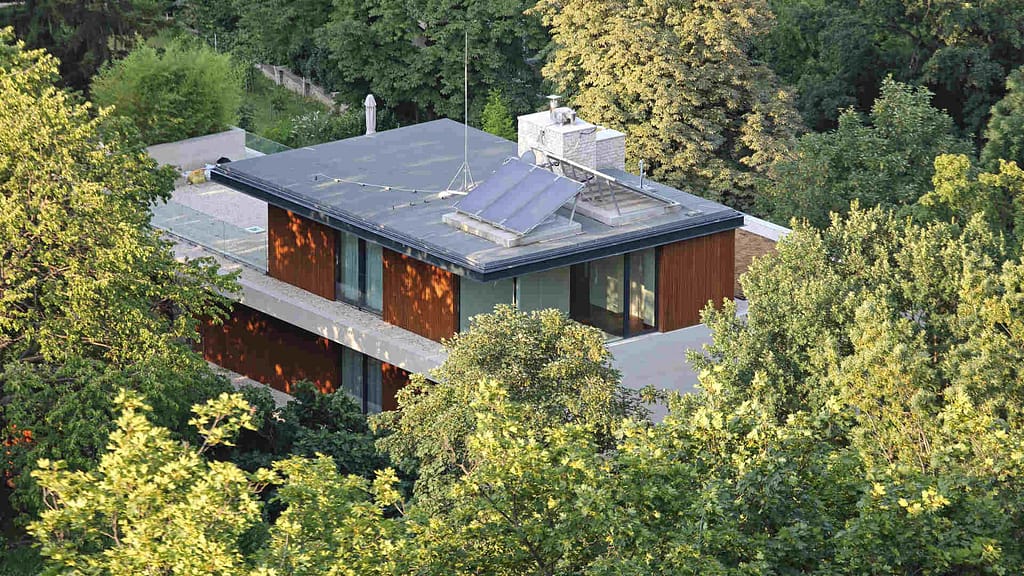Flat roofs are popular in modern architecture, but they may require more maintenance than pitched roofs. This blog explores whether flat roofs demand more upkeep, including common issues, comparisons with pitched roofs, and tips for proper care.
Table of contents
What is a Flat Roof?
A flat roof is a roof that has a very low slope or is almost level. Unlike pitched roofs, which have steep angles, flat roofs are nearly horizontal. They are common in modern architecture, especially in urban areas where space is limited.
Flat roofs are made from materials designed to hold up against the elements. These materials can include asphalt, rubber membranes, or layers of tar and gravel. The design of flat roofs often includes slight slopes to help with drainage, although they may still have water pooling issues if not properly maintained.
Types of Flat Roofs

There are several types of flat roofs, each with its own unique characteristics. Knowing the different types can help you understand their specific maintenance needs.
- Built-Up Roof (BUR): This is one of the oldest types of flat roofs, made up of multiple layers of tar and gravel. It’s durable and provides good protection against the elements, but it can be heavy and requires a strong supporting structure.
- Modified Bitumen: This type of roof is similar to BUR but uses a special type of asphalt that is more flexible. It’s easier to install and repair than BUR, making it a popular choice for many homeowners.
- Rubber Membrane (EPDM): EPDM roofs are made from a single-ply rubber material. They are lightweight, easy to install, and offer good resistance to UV rays and weather damage. However, they can be punctured more easily than other types of flat roofs.
Check out our blog "What is the Best Material for a Flat Roof?" to learn more about the different types of flat roofs.
Common Maintenance Issues with Flat Roofs

Like any roofing system, flat roofs come with their own set of challenges. This section will cover the most common maintenance issues that flat roof owners might face. Understanding these problems will help you stay ahead of potential issues and keep your roof in top shape.
Drainage Problems
One of the most common issues with flat roofs is drainage. Unlike pitched roofs, flat roofs don’t have a steep slope to naturally guide water away. This means that water can pool on the surface, leading to leaks and water damage. Regular inspections are important to ensure that drains and gutters are clear and functioning properly. Adding extra drainage or increasing the slope slightly can help reduce these issues.
Membrane Wear and Tear
Flat roofs rely heavily on their membrane to keep water out. Over time, the membrane can develop cracks, blisters, or punctures, especially if the roof is frequently walked on. These small issues can quickly become bigger problems if not addressed. Regular checks for signs of wear and tear can help you catch these issues early. If you notice any damage, it’s important to repair it right away to prevent leaks.
UV Damage
Flat roofs are constantly exposed to the sun, which can cause the materials to degrade over time. UV rays can break down the roof’s membrane, making it brittle and more prone to cracks. To protect your flat roof, you can apply a reflective coating that helps reduce UV damage. This simple step can extend the life of your roof and reduce the need for repairs.
Comparing Maintenance Needs: Flat Roofs vs. Pitched Roofs
To truly understand whether flat roofs require more maintenance, it’s helpful to compare them with pitched roofs. This section provides a side-by-side look at the inspection frequency, repair costs, and durability of flat versus pitched roofs.
Inspection Frequency
Both flat and pitched roofs require regular inspections to catch any potential problems early. However, flat roofs generally need to be inspected more often due to their higher risk of water pooling and membrane damage. It’s recommended to inspect a flat roof at least twice a year, and after any major storms. Pitched roofs, on the other hand, usually only need an inspection once a year unless there’s a specific reason to check for damage.
Cost of Repairs
The cost of repairing a flat roof can vary depending on the type of damage. In general, flat roofs can be more expensive to repair than pitched roofs because they require more frequent attention and specialized materials. For example, fixing a leak on a flat roof may involve replacing large sections of the membrane, whereas a similar repair on a pitched roof might only require replacing a few shingles.
Longevity and Durability
Flat roofs tend to have a shorter lifespan than pitched roofs. This is partly due to their higher maintenance needs and the wear and tear they experience from constant exposure to the elements. With proper maintenance, a flat roof can last 20 to 25 years, while a well-maintained pitched roof can last 30 years or more. The difference in durability means that you may need to replace a flat roof sooner, which is another factor to consider when choosing between the two.
Pros and Cons of Flat Roofs

While flat roofs may require more maintenance, they also come with several advantages. This section explores the pros and cons of flat roofs, helping you weigh the benefits against the potential drawbacks.
Pros
Flat roofs come with several advantages that make them appealing despite their maintenance needs:
- Space Utilization: One of the biggest benefits of a flat roof is the extra usable space it provides. Many homeowners use flat roofs as outdoor living spaces, creating rooftop gardens, patios, or even installing solar panels.
- Modern Aesthetic: Flat roofs give buildings a sleek, contemporary look that appeals to many people. They are often used in modern architecture to create clean lines and a minimalist appearance.
- Easier Access: Flat roofs are generally easier to access than pitched roofs, making maintenance and repairs simpler. You can easily walk on a flat roof without the risk of slipping or falling, which can make tasks like cleaning gutters or checking for damage less daunting.
Cons
However, there are also some disadvantages to consider:
- Higher Maintenance Requirements: As mentioned earlier, flat roofs require more frequent inspections and maintenance to prevent issues like leaks and water damage. This can be time-consuming and costly over the life of the roof.
- Potential for Water Damage: Flat roofs are more prone to water damage due to their lack of natural drainage. If water pools on the roof and isn’t removed, it can lead to serious structural problems.
- Shorter Lifespan: While flat roofs can last a long time with proper care, they generally have a shorter lifespan than pitched roofs. This means you may need to replace your roof sooner, which can be a significant expense.
Tips for Maintaining a Flat Roof
Regular maintenance is key to prolonging the life of your flat roof. In this section, you’ll find practical tips on how to keep your flat roof in the best condition possible.
Regular Inspections
To keep your flat roof in good condition, it’s important to perform regular inspections. Look for signs of damage like cracks, blisters, or water pooling, and address any issues as soon as possible. It’s a good idea to check your roof at least twice a year, and after any major storms that could cause damage.
Immediate Repairs
Don’t wait to fix problems when they arise. Small issues like a tiny crack in the membrane can quickly become major leaks if left unchecked. If you notice any damage, make the necessary repairs right away to prevent more serious problems down the line.
Professional Maintenance Services
While you can manage some basic maintenance tasks on your own, there are times when it’s wise to call in the experts. Hiring a professional roofer for more complex jobs ensures that your flat roof gets the care it needs. A skilled roofing contractor can conduct a thorough inspection, identify any issues, and carry out necessary repairs. They can also apply protective coatings that extend the life of your roof, helping you avoid costly problems down the road.
If you’re not sure where to start, Instant Roofer makes it easy to find a roofer and connect with trusted contractors in your local area. Additionally, if your roof is nearing the end of its lifespan, you may be considering a full replacement. In that case, you can use our roof replacement cost calculator to get a fast and free estimate in seconds.
Conclusion
Flat roofs offer many benefits, including additional usable space and a modern aesthetic. However, they do require more maintenance than pitched roofs, especially when it comes to preventing water damage and addressing membrane wear and tear. Regular inspections, immediate repairs, and professional maintenance services are key to keeping your flat roof in good condition. By understanding the maintenance needs of flat roofs and taking proactive steps, you can enjoy the advantages of a flat roof without being caught off guard by unexpected problems.
Fact checked by Adrian Catolico - 8/13/2024

